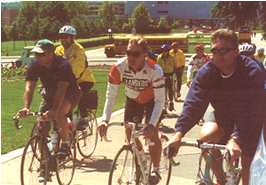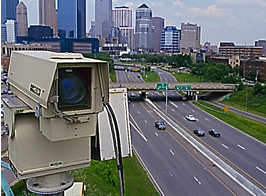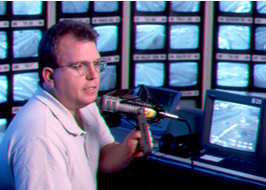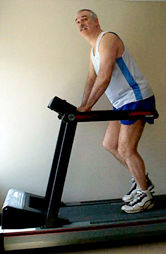 |
 |
 |
Minnesota will celebrate 10th B-BOP Day
|
 |
 |
 |
It's a hard morning's ride for some of the participants
who bicycled to work for last year’s B-BOP day. Photo by Dave Gonzalez
|
Mn/DOT will join other agencies, private firms and individuals to celebrate
B-BOP (Bike Bus or Pool) Day on Thursday, May 17, the state’s annual reminder
to commuters to try an alternative to driving alone.
B-BOP Day’s purpose includes focusing attention on using bus transit, carpools,
vanpools, walking, biking and telecommuting to alleviate congestion and reduce
demand on the state’s transportation system.
This year’s celebration will include top state officials, including Commissioner
Elwyn Tinklenberg, biking from the Governor’s Mansion to the Capitol, an organized
set of bike rides in Rochester and promotional events that will be held by private
and public employers.
At the Capitol, B-BOPers can visit commuting-related displays and obtain information
about commuting options. A three-mile walk along the Gateway Trail will begin
at I-35E and Arlington Avenue at 6:45 a.m. Walkers will arrive at the Capitol
at 8 a.m.
New this year is a Web connection that allows B-BOP Day participants to pledge
their participation and register for prizes electronically on the B-BOP Day Web site.
Mn/DOT employees can obtain an official B-BOP button that will enable them
to ride Metro Transit buses free all day on May 17. To obtain a button, and
for more information about B-BOP Day, contact Jarvis Keys, Transit, 651/297-3702.
 |
Newly licensed bus driver Brian Jergenson, Rochester public affairs
coordinator, is in the driver's seat of a major league pool vehicle.
|
Rochester’s Jergenson puts himself in the driver’s seat on B-BOP Day
On B-BOP Day, one Mn/DOT employee may literally be in the driver’s seat of
a major league pool vehicle. Part-time driver Brian Jergenson, Rochester public
affairs coordinator, may drive a 45-passenger bus from Spring Valley where he
lives to Rochester.
Jergenson’s passengers include people who work at the Mayo Clinic, Methodist
Hospital and other businesses in Rochester. Jergenson’s 25-mile route takes
about 50 minutes each way. At the end of his route, newly licensed bus driver
Jergenson parks the yellow and white Rochester City Lines passenger bus at the
district headquarters where he works and then begins his regular public affairs
job.
“I go that way anyway and the price of gas is getting higher, so I might as
well get paid for it,” Jergenson said. He added that as a member of a multi-modal
agency, he believes it’s appropriate to become part of the solution by driving
the commuter bus.
Passengers on the comfortably cushioned bus read or talk in the morning, he
added, but the bus is much quieter on the way back to Spring Valley.
By Craig Wilkins
|
back

|
 |
Twin Cities congestion growth ranked 2nd in nation
|
 |
 |
Twin Cities motorists spent almost one workweek in 1999 tied up in traffic,
according to a study released May 7 by the Texas Transportation Institute.
That statistic puts Minneapolis/St. Paul second to Atlanta in the rate of congestion
growth and ranks the metropolitan area as the nation’s 15th most congested.
In 1998, the Twin Cities area ranked 18th in congestion and in 1990, it ranked
34th.
According to the 2001 Urban Mobility Study, Twin Cities motorists spent an
average of 38 hours sitting in traffic in 1999, compared to the 18 hours they
spent in 1992—a whopping 111 percent increase in seven years. The national average
was 36 hours.
“Congestion in the metro area is getting worse and
at a faster pace than anywhere in country,” said Commissioner Elwyn Tinklenberg,
who spent much of Monday talking to the news media about the study results.
“Nobody should be surprised by this. The public has been saying it. Mn/DOT has
been saying it and the research institutions are saying it. The Legislature
needs to take seriously the fact that we must address our transportation needs
now.”
With just 12 days until the scheduled end of the legislative session, Mn/DOT
still does not know how much transportation funding will be available for the
next biennium.
Congestion costs Twin Cities motorists $1.57 billion annually, an 18 percent
increase since 1997, compared to an 8 percent nationwide increase. That’s a
cost of $670 per person, a 15 percent hike from the $570 per person in 1997.
Costs are figured on hours of delay and wasted fuel.
So how can the problem be fixed? The report concludes that a “roads only” approach
is not the answer.
“In many of the nation’s most congested corridors there doesn’t seem to be
the space, money and public approval to add enough road space to create an acceptable
condition,” according to the report. “The solution is really a diverse set of
options that require funding commitments, as well as a variety of changes in
the ways that transportation systems are used.”
In 1997, the study found it would take adding 37 lane miles per year to keep
mobility current. That figure jumped to 49 in 1999, an increase of 32 percent.
“Even if we could physically build to this rate, would we want to?” Tinklenberg
said. “This would have a significant impact on the green space that we all value
so much.”
The study is intended to communicate road conditions and the need for improvements
and is sponsored by 11 state transportation agencies, including Mn/DOT.
See the Texas Transportation Institute Web site for more information on the
urban mobility study.
Click here to view Mn/DOT’s legislative
summaries to date.
|
back

|
 |
Traffic management system now available for most Twin Cities roadways
|
 |
 |
 |
|
This closed-circuit camera on I-35W just south of
downtown Minneapolis gives Traffic Management Center staff a bird’s-eye
view of everyday traffic flows. If an incident occurs (accident, stalled
vehicle, etc.), staff can contact the State Patrol, call 9-1-1, and so
on. Photo by Kent Flemmer, Flemmer Photography
|
Congestion is rising in the Twin Cities Metro area, according to the latest
study from the Texas Transportation Institute, but tools for commuters and travelers
for dealing with congestion are also increasing.
In April, Mn/DOT reached a milestone in helping travelers get around town:
the traffic management system run by Mn/DOT’s Traffic Management Center now
covers 75 percent of the Twin Cities area, according to Robin Bellamy, TMC motorist
information officer.
This traffic management system includes:
§
Closed-circuit television cameras
§
Road sensors that measure the speed and volume of traffic on the
roadways
§
Overhead electronic message signs attached to bridges and overpasses
As of last month, Hwy 10 has 14 new cameras, road sensors
every half-mile, and three electronic message signs—putting the entire system
at the 75 percent coverage point, Bellamy said. Hwy 10 runs 11 miles from I-35W,
Mounds View to Greenhaven Avenue, Coon Rapids in the northern suburbs.
The road sensors (also called “loop detectors”) supply information
that TMC staff members, and several private partners, can then use to provide
real-time traffic conditions on Twin Cities highways. Motorists can learn what
current driving conditions are like by simply:
§
Logging onto Mn/DOT’s Web
site before leaving home or the office, then click on “Getting Around”
§
Tuning into KBEM 88.5 FM Radio while in the Twin Cities
§
Reading, while en route, the overhead electronic messages which
warn of incidents and congestion ahead
 |
|
Surrounded by television monitors showing rush hour
traffic conditions on the Twin Cities roadways, Mike Mauren describes
the traffic flows for his KBEM FM Radio listeners. Photo provided by
TMC
|
Motorists can hear live traffic reports Monday through Friday on KBEM Radio
at these times:
§
Every 10 minutes between 6:00 a.m. and 9:00 a.m.
§
Every half hour between 11:30 a.m. and 1:00 p.m.
§
Every 10 minutes between 3:30 p.m. and 7:00 p.m. (beginning at
2:30 p.m. on Fridays)
§
Extended coverage when major traffic incidents occur
Mn/DOT’s Web site provides a detailed, color-coded congestion
map with incident icons and road construction information, with updates every
60 seconds. In addition, site visitors can print out a text version of the map.
Several other Web sites that partner with Mn/DOT also display
maps with real time traffic information. (See http://www.dot.state.mn.us/metro/around.html
for links to current partners.)
|
back

|
 |
Committee provides focal point for traffic research
|
 |
 |
Mn/DOT has established a Traffic Research Coordinating Committee to serve as
a focal point for all traffic-related research within the department, said Gary
Thompson, state traffic engineer and committee chairperson.
This will allow customers and Mn/DOT employees to easily locate information
on past and current research, he said. Information eventually will be housed
on the Office of Traffic
Engineering Web site.
Besides listing completed projects and tracking current projects, the committee
will solicit, prioritize and recommend traffic research projects for funding.
Thompson said the committee plans to identify various funding sources to maximize
research opportunities.
“The first year’s goal is to set up a good communications
network where someone can go to the Web site and find out about a particular
project,” he said.
Members of the group include directors of the offices of Advanced Transportation
Systems and Research Administration, metro traffic engineer, a district traffic
engineer, as well as a representative from the University of Minnesota Center
for Transportation Studies. Quarterly meetings begin the end of May.
Thompson said the group will develop methods on how to best coordinate research
efforts, which can range from very theoretical projects for university staff
to practical projects that can be implemented in the districts. For example,
Greg Gruber, District 2, and Sean Delmore, Office of Traffic Engineering, currently
are researching an emergency vehicle preemption system where traffic lights
are preempted using sirens. Such a system may be feasible for small communities
since it’s relatively inexpensive. Delmore and Gruber are evaluating system
performance and developing guidelines for effective system use.
“There is a tremendous need for communicating this information so that it is
shared and doesn’t get lost,” Thompson said.
For more information, contact Gary Thompson at 651/284-3502.
By Sue Stein
|
back

|
 |
Pedestrian safety summit to be held in St. Paul
|
 |
 |
Creating communities that are safer for pedestrians and drivers
alike is the focus of the Pedestrian Safety Summit scheduled for May 16-19 at
various locations in St. Paul.
The Saint Paul City Council, with several co-sponsors (including
Mn/DOT), is hosting the event. David Engwicht, a well-known traffic expert,
urban planner and author, is the featured speaker. He will lead panel discussions
and workshops to aid neighbors, planning professionals and lawmakers in finding
solutions to traffic and pedestrian safety problems. The events are free and
open to the public.
“During the last several years, there’s been an incredible
growth in awareness of and interest in pedestrian issues ranging from education
and enforcement to road design,” said Kristie Billiar, Mn/DOT state pedestrian
coordinator. “Mn/DOT’s participation in the upcoming summit represents the department’s
commitment to open discussion on the role of pedestrians in the state’s transportation
network.”
A large portion of the conference will be devoted to looking
at traffic calming techniques and creating community awareness, Billiar said.
“Traffic calming” is a design technique for streets—such as curbs that bump
out at crosswalks to shorten the distance a pedestrian must go to cross the
street—that encourage people to drive more slowly and improve pedestrian safety.
For more information about the conference events and locations
or about pedestrian safety, contact Kristie Billiar, 651/296-5269. See Mn/DOT’s library for information
about traffic calming and http://www.walkinginfo.org/
for information about pedestrian safety.
|
back

|
 |
Several offices find new (or improved) homes
|
 |
 |
A number of work units in Central Office have been
on the move this spring. The most recent relocation was the Office of Electronic
Communications, which returned to the 9th floor Kelly Inn in
St. Paul on May 7.
Electronic Communications—as well as Freight,
Railroads and Waterways; Advanced Transportation Systems, and the Bikeways Unit
of Environmental Services—moved in February from the 9th and 10th floors of
the Kelly Inn so that abatement work could be done to eliminate mold found in
the building, according to Bob Vang, facility manager.
Abatement work included replacing affected areas with moisture-resistant
wallboard and improving the ventilation system, he said.
Freight, Railroads and Waterways returned to the 9th floor
Kelly Inn on April 30. Advanced Transportation Systems and the Bikeways Unit
will remain on the 2nd floor Ford Building in St. Paul, where they were relocated
in February.
Other recent Central Office building moves include:
§
Passenger Rail to 7th floor west
§
Project Delivery Streamlining to 6th floor south
§
Administrative Services to ground floor
south
In addition, Publishing and Design (formerly the Word Processing
Unit) will move to 1st and 3rd floors at the end of this week. Facilities Management
will be moving or reconfiguring several other work units over the next few months
as the Central Office renovation project nears completion, Vang said.
He offers three tips for offices needing his group’s
services:
§
Put all requests in writing by sending him a GroupWise note—phone
calls and in-person messages may get lost.
§
Be detailed—describe the work that needs to be done and include
a contact name, phone number and office location.
§
Have patience—Vang said his group handles
more than 3,000 service requests each year, ranging from painting a wall, fixing
plumbing, wiring a cubicle, hanging pictures—to moving an entire office.
|
back

|
 |
Department phone directory goes online
|
 |
 |
For the first time ever Mn/DOT’s Telecommunications
Directory will be available in two formats: print and electronic, announced
Ed Clarke, director, Administrative Services.
Distribution of the printed directory to offices and districts began last week.
Test files of the online version are now
available on Mn/DOT’s intranet; these files will be replaced by the end of this
week to match the print version.
The print version data is current through Feb. 28, 2001, Clarke said. Administrative
Services is currently working with the offices of Human Resources and Information
Resource Management to create a process that will allow for a daily update of
the alphabetic (employee names) section; the process is expected to be ready
in the next few weeks. Update of the classified (office, district, work unit)
section is anticipated to occur on a six-month cycle.
Updating the online information will require offices and districts to keep
their SEMA4 data up-to-date in order to ensure accuracy of the information,
Clarke said.
“Our goal is to make the directory as useful as possible,” Clarke
said last week in a memo to all employees. With that in mind, one of the changes
made to this year’s directory, at the suggestion of the district engineers,
was including the names of all employees. Previous editions limited district
phone numbers to key functions.
In addition, the printed version is now on 8-1/2 x 11 paper and inserted into
a three-ring binder, enabling more frequent updating of its parts and making
it easier to post on the intranet, Clarke said. The directory was last updated
in January 1998.
Another improvement planned for the directory is expanding the alphabetic section
on the intranet version to allow for convenient searching of individual names
and numbers. Clarke said.
Employees are encouraged to send written comments on how the directory can
be improved to Ken Bjork via GroupWise.
|
back

|
 |
Shape-Up challenge begins May 14
|
 |
 |
 |
|
Demonstrating his commitment to getting in better
shape during Mn/DOT’s 10th annual Shape-Up Challenge, Alan Farnham,
Workforce Equity/EEO Contract Management, gives the treadmill a workout.
Photo by Kent Barnard
|
Running definitely is not the only activity encouraged for participants in
Mn/DOT’s 10th annual shape-up challenge, which runs from May 14 to June 24.
Instead, the challenge emphasizes a wide variety of lifestyle-balancing, health-enhancing
activities that we all know we “should” do, but so often don’t.
Participants may earn points each week in several “lifestyle” categories: nutrition,
lifestyle, self-care and social connection, and “time out” for relaxation. Activities
in these areas include:
§
eating one piece of fruit a day
§
taking the stairs instead of the elevator
§
wearing seat belts
§
flossing daily
§ reading
for pleasure
In the fifth category, fitness activities, participants earn points based on
the number of minutes spent doing activities such as:
§
running
§
bicycling
§
aerobics classes
§
team sports
§
martial arts
Each person who completes the six-week challenge will earn a prize. Additional
prizes will be awarded during the challenge itself. Employees may compete as
individuals or as teams.
Register by May 21, and then turn in your weekly points to your team leader,
to Steve Zvonar, Mn/DOT wellness director, or to your district’s wellness coordinator.
Metro Division employees can submit points to Joan Maxwell, Metro’s wellness
coordinator.
|
back

|
 |
Question of the week
|
 |
 |
News releases and the Mn/DOT Web site aren’t the only means to getting our
messages out to the public. One reader noticed this, and asked a question about
a smaller but no less influential method of reaching the public: talk shows
on radio (and, by extension, TV and cable).
To find out which talk show drew his attention, along with a little background
on Mn/DOT’s history with talk shows, visit this week’s Question of the
Week.
And while you are here on our site, click on the
link to send an e-mail question to us. We will select one question each
week, research out the answer, and publish it here.
|
back

|
|
 |
|


